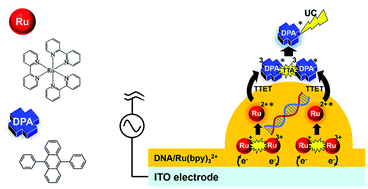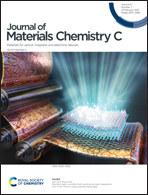Upconverted blue electrochemiluminescence of 9,10-diphenylanthracene with ultrafast response on photo-electro functional DNA/Ru(bpy)32+ hybrid electrode†
Abstract
Electrochemiluminescence (ECL), a light-emitting phenomenon induced by electrochemical redox reactions, has the potential for applications in lightweight and flexible light-emitting devices. Previously, an ultrafast ECL response below 100 μs was successfully obtained under an applied AC voltage by introducing Ru(bpy)32+, an orange ECL material, onto a DNA-modified electrode. This study introduced blue-luminescent 9,10-diphenylanthracene (DPA) into an ECL device consisting of the DNA/Ru(bpy)32+ hybrid electrodes. Consequently, blue ECL from DPA was obtained from the DNA/Ru(bpy)32+ hybrid electrode at a lower applied voltage than that required to induce the redox reactions of DPA itself. This lower-voltage-drivable blue ECL was attributed to triplet–triplet energy transfer from Ru(bpy)32+ in the DNA/Ru(bpy)32+ hybrid electrode followed by a triplet–triplet annihilation upconversion reaction of DPA in the electrolyte solution. Moreover, ultrafast-response, electrochemically triggered blue luminescence from DPA was successfully observed.



 Please wait while we load your content...
Please wait while we load your content...